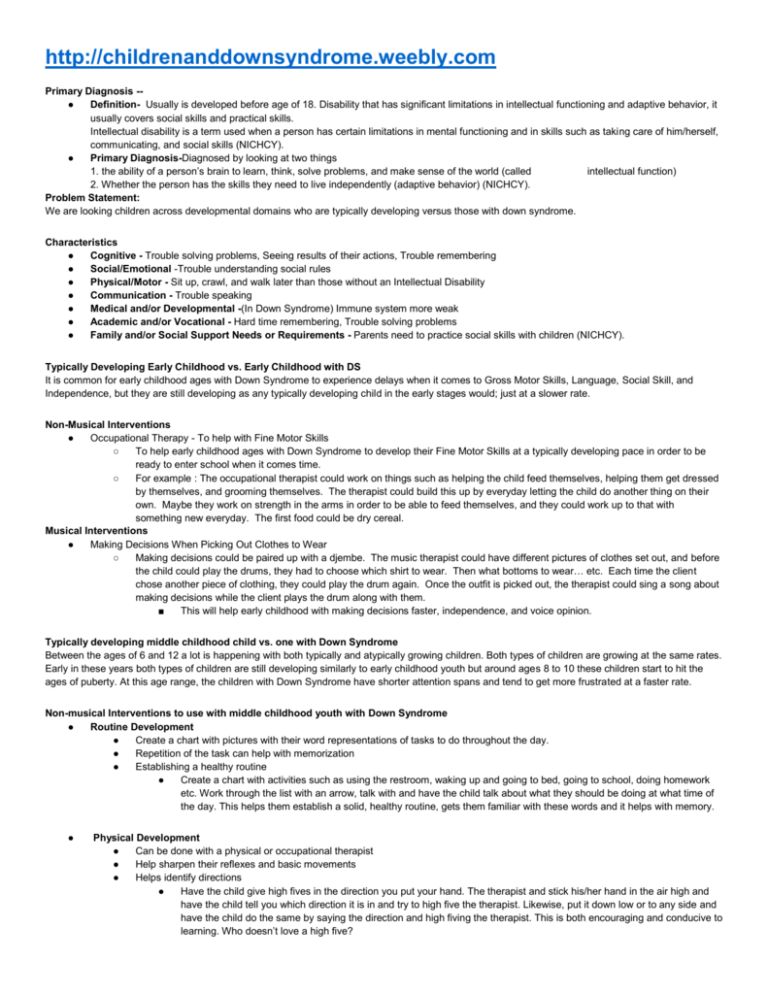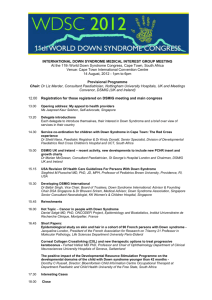File - Intellectual Disabilities in Children
advertisement

http://childrenanddownsyndrome.weebly.com Primary Diagnosis -● Definition- Usually is developed before age of 18. Disability that has significant limitations in intellectual functioning and adaptive behavior, it usually covers social skills and practical skills. Intellectual disability is a term used when a person has certain limitations in mental functioning and in skills such as taking care of him/herself, communicating, and social skills (NICHCY). ● Primary Diagnosis-Diagnosed by looking at two things 1. the ability of a person’s brain to learn, think, solve problems, and make sense of the world (called intellectual function) 2. Whether the person has the skills they need to live independently (adaptive behavior) (NICHCY). Problem Statement: We are looking children across developmental domains who are typically developing versus those with down syndrome. Characteristics ● Cognitive - Trouble solving problems, Seeing results of their actions, Trouble remembering ● Social/Emotional -Trouble understanding social rules ● Physical/Motor - Sit up, crawl, and walk later than those without an Intellectual Disability ● Communication - Trouble speaking ● Medical and/or Developmental -(In Down Syndrome) Immune system more weak ● Academic and/or Vocational - Hard time remembering, Trouble solving problems ● Family and/or Social Support Needs or Requirements - Parents need to practice social skills with children (NICHCY). Typically Developing Early Childhood vs. Early Childhood with DS It is common for early childhood ages with Down Syndrome to experience delays when it comes to Gross Motor Skills, Language, Social Skill, and Independence, but they are still developing as any typically developing child in the early stages would; just at a slower rate. Non-Musical Interventions ● Occupational Therapy - To help with Fine Motor Skills ○ To help early childhood ages with Down Syndrome to develop their Fine Motor Skills at a typically developing pace in order to be ready to enter school when it comes time. ○ For example : The occupational therapist could work on things such as helping the child feed themselves, helping them get dressed by themselves, and grooming themselves. The therapist could build this up by everyday letting the child do another thing on their own. Maybe they work on strength in the arms in order to be able to feed themselves, and they could work up to that with something new everyday. The first food could be dry cereal. Musical Interventions ● Making Decisions When Picking Out Clothes to Wear ○ Making decisions could be paired up with a djembe. The music therapist could have different pictures of clothes set out, and before the child could play the drums, they had to choose which shirt to wear. Then what bottoms to wear… etc. Each time the client chose another piece of clothing, they could play the drum again. Once the outfit is picked out, the therapist could sing a song about making decisions while the client plays the drum along with them. ■ This will help early childhood with making decisions faster, independence, and voice opinion. Typically developing middle childhood child vs. one with Down Syndrome Between the ages of 6 and 12 a lot is happening with both typically and atypically growing children. Both types of children are growing at the same rates. Early in these years both types of children are still developing similarly to early childhood youth but around ages 8 to 10 these children start to hit the ages of puberty. At this age range, the children with Down Syndrome have shorter attention spans and tend to get more frustrated at a faster rate. Non-musical Interventions to use with middle childhood youth with Down Syndrome ● Routine Development ● Create a chart with pictures with their word representations of tasks to do throughout the day. ● Repetition of the task can help with memorization ● Establishing a healthy routine ● Create a chart with activities such as using the restroom, waking up and going to bed, going to school, doing homework etc. Work through the list with an arrow, talk with and have the child talk about what they should be doing at what time of the day. This helps them establish a solid, healthy routine, gets them familiar with these words and it helps with memory. ● Physical Development ● Can be done with a physical or occupational therapist ● Help sharpen their reflexes and basic movements ● Helps identify directions ● Have the child give high fives in the direction you put your hand. The therapist and stick his/her hand in the air high and have the child tell you which direction it is in and try to high five the therapist. Likewise, put it down low or to any side and have the child do the same by saying the direction and high fiving the therapist. This is both encouraging and conducive to learning. Who doesn’t love a high five? Typically developing adolescent versus one with Down Syndrome While adolescents with Down Syndrome do suffer from some social and school delays , they develop the same way that all adolescents do. Adolescents reach puberty at about the same age as those who do not have Down Syndrome. Adolescents with Down Syndrome also develop social and emotional needs, leisure interests, and awareness of sexuality. (National Down Syndrome Society, 2012) Non-musical Intervention to use with adolescents with Down Syndrome: Reading activities to help with verbal skills ● Using easy reading and helping with difficult words ● Slowing down reading for better comprehension ● Allowing adolescent to reflect and put reading in their own words ○ Pick a book that is on the adolescent’s reading level and do not make it too easy as to not hurt the adolescent’s self esteem. Have the adolescent read a paragraph at a time, slowing the reading down to help understand. Then when the adolescent has finished reading the paragraph, allowing them to reflect on what they have just read, and then asking them to put what the paragraph was about in their own words. Reading musical books to improve comprehension ● Reading popular books in song form ● Allowing adolescent to sing the book back once you have read it ● Asking questions through a written song about the book you have read Resources (Brodeur, J. (2008). Music therapy for children with down syndrome. Music Therapy: A Sound Decision,) Down syndrome education international. (2013). Retrieved from http://www.dseinternational.org/en-gb/ Down syndrome research and treatment foundation. (2012). Retrieved from http://www.dsrtf.org/ Lynn, M. (2011, May 04). Activities using music with down's syndrome children. Retrieved from http://www.livestrong.com/article/132563-activities-using-music-with-downs-syndrome-children/ NACD. (2009). Down syndrome. Retrieved from downsyndrome.nacd.org National Down Syndrome Society. (2012). Adolescence & adulthood. Retrieved from http://www.ndss.org/resources/adolescence-adulthood/. National dissemination center for children with disabilities. (n.d.). Retrieved from http://nichcy.org/disability/specific/intellectual WETA. (2010). Adults with ld. Retrieved from http://www.ldonline.org/ Fisher, N. (n.d.). How can down syndrome affect a child's development . Retrieved from http://everydaylife.globalpost.com/can-down-syndrome-affectchilds-development-2369.html




